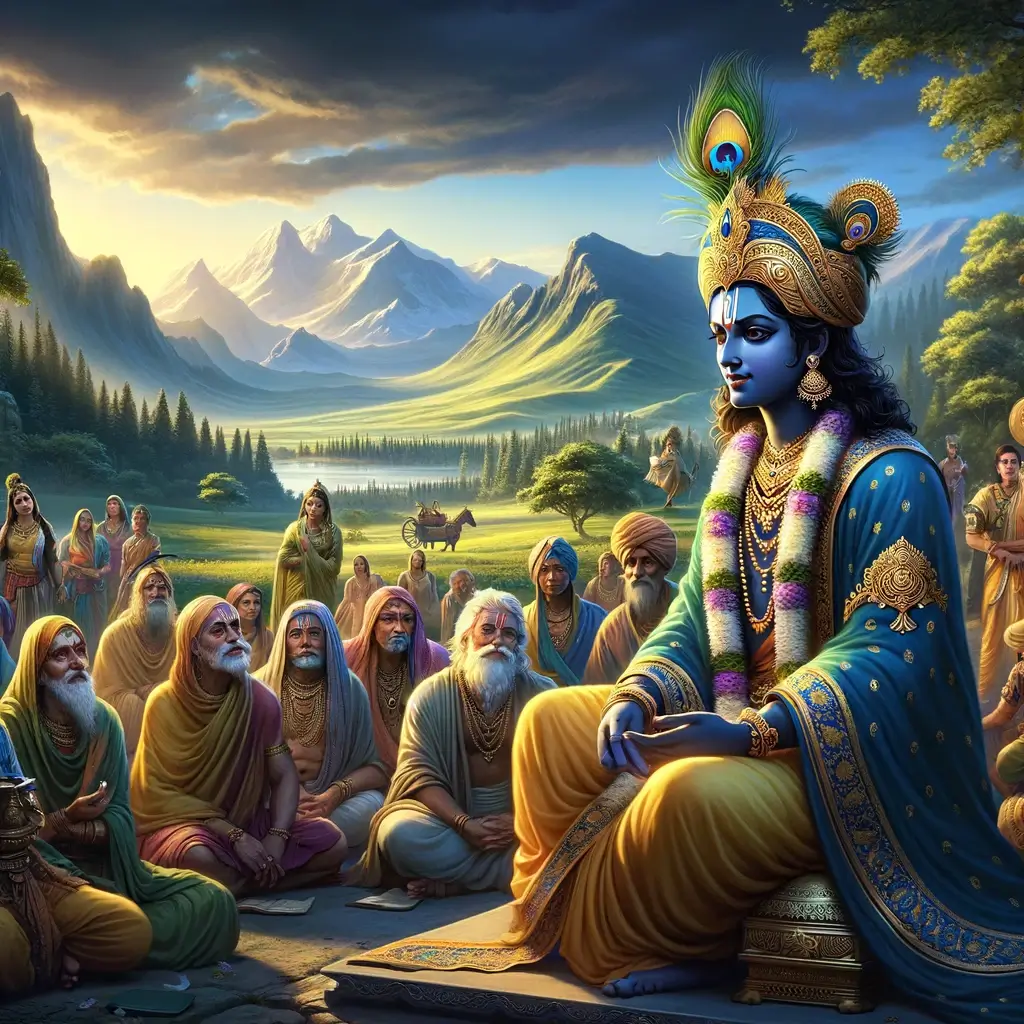Table of Contents
Losing someone we love is one of the hardest things we face in life. It can feel like being lost in a dark place, trying to find some light. The Bhagavad Gita an ancient book full of wisdom, talks about these tough times. It shares ideas that can help us feel a bit better and see things differently. The Bhagavad Gita tells us about how life and death are part of a bigger plan and how understanding this can bring us peace. Let’s explore how this old book can help us deal with losing someone and make us feel not so alone in our sadness.
संजायते म्रियते वा कदाचिन्नायं भूत्वा भविता वा न भूयः।
Chapter 2, Text 13
अजो नित्यः शाश्वतोऽयं पुराणो न हन्यते हन्यमाने शरीरे॥
Translation:
“As the embodied soul continuously passes, in this body, from boyhood to youth to old age, the soul similarly passes into another body at death. A sober person is not bewildered by such a change
Meaning as imparted by Lord Krishna:
Lord Krishna explains the transient nature of the physical body and the permanence of the soul. Just as a person grows from childhood to old age, the soul similarly transitions from one body to another, signifying that death is not the end but a continuation of the soul’s journey
न जायते म्रियते वा कदाचित् नायं भूत्वा भविता वा न भूयः।
Chapter 2, Text 20
अजो नित्यः शाश्वतोऽयं पुराणो न हन्यते हन्यमाने शरीरे॥
Translation:
“For the soul, there is never birth nor death. Nor, having once been, does he ever cease to be. He is unborn, eternal, ever-existing, undying and primeval. He is not slain when the body is slain

Meaning as imparted by Lord Krishna:
Krishna reassures us that the soul is immortal and does not succumb to birth or death. Unlike the body, the soul does not undergo the cycle of coming into being or perishing. It remains constant, unaffected by the physical destruction of the body
वासांसि जीर्णानि यथा विहाय नवानि गृह्णाति नरोऽपराणि।
Chapter 2, Text 22
तथा शरीराणि विहाय जीर्णान्यन्यानि संयाति नवानि देही॥
Translation:
“As a person puts on new garments, giving up old ones, the soul similarly accepts new material bodies, giving up the old and useless ones
Meaning as imparted by Lord Krishna:
The soul’s transition from one body to another is likened to a person changing clothes. Just as we discard worn garments for new ones, the soul leaves an aged body to enter a new one. This illustrates the continuation of life beyond the physical realm
नैनं छिन्दन्ति शस्त्राणि नैनं दहति पावकः।
Chapter 2, Text 23
न चैनं क्लेदयन्त्यापो न शोषयति मारुतः॥
Translation:
“Weapons cannot shred the soul, nor can fire burn it. Water cannot wet it, nor can the wind dry it.
Meaning as imparted by Lord Krishna:
The soul is impervious to any harm from the physical elements. It stands invincible against weapons, fire, water, and air, symbolizing its eternal and indestructible nature
अच्छेद्योऽयमदाह्योऽयमक्लेद्योऽशोष्य एव च।
Chapter 2, Text 24:
नित्यः सर्वगतः स्थाणुरचलोऽयं सनातनः॥
Translation:
This individual soul is unbreakable and insoluble, and can be neither burned nor dried. It is everlasting, present everywhere, unchangeable, immovable, and eternally the same.
Meaning through the words of Lord Krishna:
Lord Krishna elucidates the indestructible nature of the soul, which remains untouched by physical forces. It cannot be cut by weapons, burned by fire, moistened by water, or withered by the wind. This eternal soul is consistent, pervades all of existence, and is a constant in the ever-changing flux of the material world
अव्यक्तोऽयमचिन्त्योऽयमविकार्योऽयमुच्यते।
Chapter 2, Text 25
तस्मादेवं विदित्वैनं नानुशोचितुमर्हसि॥
Translation:
It is said that the soul is invisible, inconceivable, and unchangeable. Knowing this, you should not grieve for the body.
Meaning through the words of Lord Krishna:
Lord Krishna speaks of the soul’s ineffable qualities. It is beyond the grasp of the senses and the mind’s conception, and it does not undergo change. With this understanding, one should not fall into despair over the physical demise, for the essence of being—the soul—remains unaltered
अथ चैनं नित्यजातं नित्यं वा मन्यसे मृतम्।
Chapter 2, Text 26
तथापि त्वं महाबाहो नैनं शोचितुमर्हसि॥
Translation:
If, however, you think that the soul is perpetually born and always dies, still you have no reason to lament, O mighty-armed.
Meaning through the words of Lord Krishna:
Lord Krishna challenges the perspective on birth and death, proposing that even if one believes the soul undergoes constant birth and death, there is still no cause for mourning. For in every perceived end is also the beginning of a new manifestation.
जातस्य हि ध्रुवो मृत्युर्ध्रुवं जन्म मृतस्य च।
Chapter 2, Text 27
तस्मादपरिहार्ये ऽर्थे न त्वं शोचितुमर्हसि॥
Translation:
For one who is born, death is certain, and for one who is dead, birth is certain. Therefore, in the unavoidable discharge of your duty, you should not lament.
Meaning through the words of Lord Krishna:
Lord Krishna states a fundamental truth of existence: birth inevitably leads to death, and death leads to rebirth. This cycle is inescapable and a natural aspect of the soul’s journey. Thus, one should not grieve over the inevitable, but rather engage in their duties with this wisdom in mind.
The journey through grief is long and full of ups and downs. The Bhagavad Gita offers us gentle reminders that we are not alone in our feelings and that there is a way to find peace. It teaches us that everyone goes through this and that it’s okay to feel sad, but also that there is hope and light ahead.
By looking at death through the eyes of the Bhagavad Gita we can start to see it not just as an end but as a part of something much bigger. It doesn’t take away the pain, but it can make it a little easier to bear, knowing that there’s a path to peace and understanding. Let the lessons from the Bhagavad Gita guide you towards finding your peace in the midst of loss
What does the Bhagavad Gita say about the nature of the soul after death?
The Bhagavad Gita explains that the soul is eternal and does not perish when the body dies. Death is described as a mere transition from one physical form to another, and the soul continues its journey unaltered by physical death
How can the Bhagavad Gita’s perspective on death provide comfort to those who are grieving?
The Gita offers a comforting perspective by teaching that the soul is indestructible and eternal. Understanding that the loved one’s essence, their soul, is beyond harm and continues beyond physical death can bring solace to those left behind.
Can the teachings of the Bhagavad Gita on death help someone who fears dying?
Yes, the Gita’s teachings can help alleviate the fear of death by shifting the focus from the physical to the spiritual, emphasizing the unchanging, eternal nature of the soul as distinct from the temporary body
What guidance does the Bhagavad Gita offer for coping with the death of a loved one?
The Gita encourages individuals to engage in their duties and to maintain a balanced perspective on life and death. It suggests that acceptance of the natural cycle of birth and death can aid in coping with loss
How does the Bhagavad Gita propose we deal with the impermanence of life?
The Gita advises that recognizing the impermanence of the physical body and focusing on the permanence of the soul can lead to a more fulfilling life. By understanding that the soul is eternal, one can approach life with detachment from the temporary and invest in spiritual growth
Is there a prescribed way to mourn according to the Bhagavad Gita?
The Gita does not prescribe a specific way to mourn but suggests that deep understanding and spiritual wisdom can transform grief into a more peaceful acceptance of the inevitable nature of life and death.
Does the Bhagavad Gita suggest that one should not grieve at all?
While the Gita acknowledges the natural human response to grieve, it also offers a perspective that aims to rise above the initial reaction to loss by understanding the eternal nature of the soul and the transient nature of the body.
What is the Bhagavad Gita’s view on the cycle of life and death?
The Gita views life and death as a continuous cycle where the soul undergoes various births and deaths. This cycle is part of the soul’s eternal journey towards self-realization and ultimate liberation.
Can the wisdom of the Bhagavad Gita on death help in everyday life
Yes, the principles outlined in the Gita can help individuals live with greater purpose and less fear, embracing a life of righteous action and detachment from the fear of death.
Also read
Bhagavad Gita on Anger Control:12 Transformative Strategies for Inner Peace
Mahabharata Family Tree Explained: Discovering the Epic’s Legendary Ancestry



